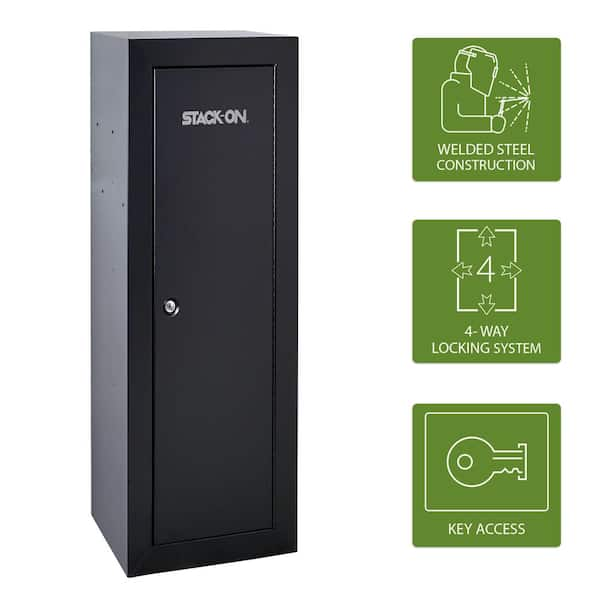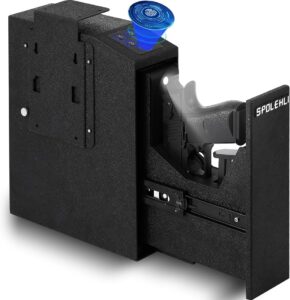Gun safe locking mechanisms secure firearms through either mechanical or electronic means. They ensure safe storage and prevent unauthorized access.
Understanding gun safe locking mechanisms is crucial for gun owners who prioritize safety and security. These mechanisms come in various types, including traditional key locks, combination dial locks, and modern biometric systems. Key locks are straightforward and reliable but may pose a risk if the key is lost or stolen.
Combination dials offer a keyless entry, relying on the user’s ability to remember the combination, while electronic keypads allow quick access with a personalized code. Biometric safes provide the highest level of security, granting entry only through fingerprint recognition technology. Choosing the right gun safe lock depends on individual needs for access speed, level of security, and personal preference. Proper understanding helps owners strike the right balance between ease of access for authorized users and prevent potential tragedies involving children or intruders.

Credit: www.amazon.com
The Evolution Of Gun Safe Locks
Safeguarding firearms has transformed dramatically over time. Early gun safes featured simple locks. Today, we witness advanced biometric systems. Each step in this evolution has enhanced security significantly. This journey reflects the technology’s progression to protect both firearm owners and their precious assets effectively.
From key locks to biometricsFrom Key Locks To Biometrics
Key locks served as the cornerstone of security for many years. These locks were straightforward. A key turned a mechanism allowing access. Yet, the simplicity also meant vulnerabilities. Keys could be lost or copied, posing a risk.
Combination locks enhanced security next. By requiring a memorized code, they reduced risks associated with key locks. But remember, patience and skill could outsmart them.
Enter biometrics — the game changer. Biometric safes use unique personal traits, like fingerprints. This provides a higher security level. No two prints are alike. So, the chances of unauthorized access dwindle dramatically.
Technological leaps in securityTechnological Leaps In Security
Electronic locks arrived, introducing digital keypads. They allowed users to set personalized codes. Some even included features to lock the safe after several incorrect attempts.
Wi-Fi-enabled locks now offer remote access. These models send alerts if the safe experiences tampering. They mark a leap in proactive security measures.
The latest smart safes integrate with home security systems. They can be monitored via smartphone apps. Owners can control access in real-time, even when away.
Summary in a list format- Key locks: Basic but vulnerable.
- Combination locks: More secure with memorized entry.
- Electronic keypads: Personal codes with lockout features.
- Biometrics: Unique personal identification for access.
- Wi-Fi-enabled: Alerts and remote management features.
- Integration with home systems: Ultimate control and security.

Credit: www.homedepot.com
Types Of Gun Safe Locking Systems
Keeping firearms secure yet accessible can be a balancing act. Different gun safe locking systems offer unique benefits. Understanding these options ensures the right balance between security and ease of access.
Mechanical Dial Locks
Mechanical dial locks stand the test of time. They require no power source. This makes them reliable and durable. A combination is dialed manually to unlock the safe.
Electronic Keypads
Electronic keypads offer quick access. They run on batteries and sport easy-to-use numbered pads. Users enter a preset code for fast entry.
Biometric Scanners
Biometric scanners use unique physical traits for identification. Fingerprints are the most common. This technology provides a high level of personalized security.
Rfid And Smart Locks
RFID and smart locks are innovative and convenient. They allow access through radio frequency identification devices or smartphones. These systems often provide remote monitoring capabilities.
Key Features Of Reliable Locking Mechanisms
When choosing a gun safe, the lock’s reliability is critical. A strong lock keeps guns safe. Certain features ensure a lock meets high standards. Let’s explore the features that make gun safe locking mechanisms trusted.
Durability And Tamper Resistance
Strong locks resist break-ins. Look for these qualities:
- Thick steel construction – Heavier gauges resist drilling.
- Anti-tamper designs – Locks with relocker systems withstand break-in attempts.
- Hardened steel plates – Protects against drilling and cutting.
Fire And Water Protection
Your gun safe should withstand natural hazards. Reliable features include:
- Fire-resistant materials – A good lock has fireproof materials to protect content.
- Waterproof seals – Keeps moisture out even when submerged or during a flood.
Battery Life And Power Options
Electronic locks need good power options:
| Feature | Benefit |
|---|---|
| Long battery life | Less frequent replacements required. |
| Backup power capabilities | Guarantees access during power loss. |
| Low battery indicators | Prompt for timely battery changes. |

Credit: www.homedepot.com
Pros And Cons Of Different Lock Types
Ensuring the safe storage of firearms is a crucial responsibility for gun owners. Choosing the right locking mechanism for a gun safe is fundamental to balancing security with accessibility. Each lock type brings its own set of advantages and disadvantages. Let’s explore these to help make an informed decision.
Comparing Ease Of Access
Understanding how quickly a gun owner can access their weapon is pivotal in emergency situations. Below are differing lock types and their impact on accessibility:
- Biometric locks: Provide swift access with a fingerprint scan.
- Electronic keypads: Require a memorized code, can be fast but less so than biometrics.
- Mechanical combination locks: Slower, require multiple steps to open.
- Key locks: Depend on physical key availability, potentially slow.
Assessing Long-term Reliability
Durability and consistent performance over time define a lock’s reliability. Here’s how each stands in terms of long-term use:
| Lock Type | Reliability Pros | Reliability Cons |
|---|---|---|
| Biometric | High-tech, fewer moving parts | Can fail with dirty sensors or low battery |
| Electronic | Consistent operation | Dependent on power source |
| Mechanical | Does not rely on electronics | Can wear out over time |
| Key | Simple, less to malfunction | Loss of key can deny access |
Security Vulnerabilities To Consider
While the primary role of a gun safe lock is to secure, weaknesses exist that may be exploited. Let’s evaluate these risks:
- Biometric locks: May be fooled with high-quality fake fingerprints.
- Electronic keypads: Susceptible to hacking, wear patterns may reveal code.
- Mechanical combination locks: Vulnerable to expert lockpicking, though less common.
- Key locks: Keys can be copied or locks picked by skilled individuals.
Maintaining Your Gun Safe Lock
Maintaining Your Gun Safe Lock ensures the security of firearms and prevents unauthorized access. Regular maintenance and understanding of the locking system are vital for reliability. A well-maintained lock works correctly and provides peace of mind. Let’s explore how to keep your gun safe lock in top condition.
Routine Check-ups And Servicing
Conducting regular check-ups is crucial for a gun safe lock’s longevity. Mark calendar reminders for periodic maintenance. Here are simple steps to follow:
- Inspect lock parts for wear and damage.
- Clean the lock mechanism using a soft cloth.
- Oil moving parts with a lubricant recommended by the manufacturer.
- Test the lock to ensure it operates smoothly.
Contact a professional for an annual service. They will inspect complex mechanisms and replace parts if necessary.
Troubleshooting Common Issues
Gun safe locks might face issues that need quick troubleshooting:
| Issue | Solution |
|---|---|
| Stuck Lock | Apply lubricant and gently wiggle the key. |
| Key Doesn’t Turn | Ensure you’re using the correct key and check for obstructions. |
| Electronic Failure | Reset the system or replace batteries. |
| Slow Response | Clean and lubricate the lock. |
For persistent problems, consult with a locksmith. They can diagnose and fix complex issues.
Upgrading Your Locking System
An upgrade can enhance security and convenience:
- Assess the current lock for its age and reliability.
- Research modern locking systems that offer advanced features.
- Consult with experts to select a suitable lock upgrade.
- Install the new system professionally to ensure proper function.
An updated lock can include biometric scanners, electronic keypads, or EMP-resistant technology. Make sure the upgrade meets your security needs.
Best Practices For Ensuring Maximum Security
Securing guns is critical for safety in any home with firearms. To ensure maximum security, gun owners must follow some best practices. Let’s explore how to keep your gun safe as secure as possible.
Safe Placement And Concealment
Where you place your gun safe plays a huge role in security. Follow these tips for optimal safe placement:
- Keep the safe out of sight to avoid drawing attention.
- Choose a location that is hard for burglars to access.
- Avoid obvious places like the master bedroom or garage.
- Anchor the safe to the ground or wall for added security.
Combining Lock Mechanisms
Using more than one lock type can greatly improve security. Combine these mechanisms:
| Mechanism Type | Security Level |
|---|---|
| Biometric scanner | High |
| Electronic keypad | Medium |
| Mechanical dial | Medium |
| Key lock | Basic |
Consider a setup with a biometric scanner and a mechanical dial for ultimate safety.
Creating A Comprehensive Safety Plan
Your guns should always be part of a larger safety strategy. Use these steps to create a solid plan:
- Create rules for gun handling and share them with everyone in your home.
- Have a routine for checking and maintaining locks on your safe.
- Combine physical and digital security measures for a foolproof system.
- Plan regular safe inspections to ensure mechanisms are functioning properly.
Frequently Asked Questions For Understanding Gun Safe Locking Mechanisms
How Does A Safe Locking Mechanism Work?
A safe locking mechanism typically involves a combination of pins or levers that align correctly only with the right key or combination, effectively securing the lock until the proper opening method is used. This precise alignment allows the lock bolt to move, granting access.
What Is The Best Locking Mechanism For A Gun Safe?
The best locking mechanism for a gun safe is a biometric lock, combining high security with quick access.
What Are The Different Types Of Gun Safe Locks?
Gun safe locks come in several types, including mechanical combination locks, electronic keypads, biometric scanners, key locks, and multiple lock systems for added security.
What Is The Difference Between A Group 1 And A Group 2 Lock?
Group 1 locks are standard for residential use, offering basic security. Group 2 locks provide enhanced security and are typically used in commercial settings due to stricter construction and manipulation resistance requirements.
Conclusion
Securing firearms is crucial for safety and peace of mind. The right gun safe locking mechanism blends security with ease of access. Whether you opt for traditional keys, combination locks, or advanced biometrics, the priority remains the same: responsible storage.
Remember, your choice reflects personal needs and security concerns. Stay informed and choose wisely to protect what matters most.


